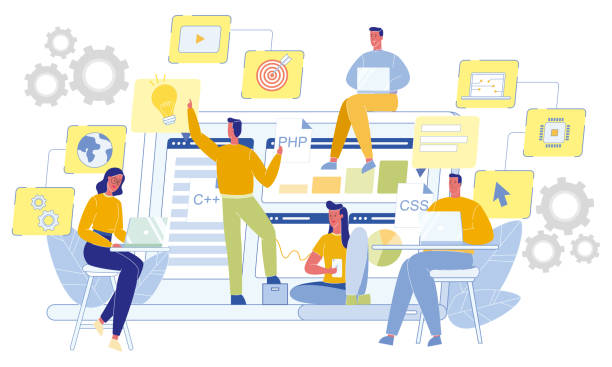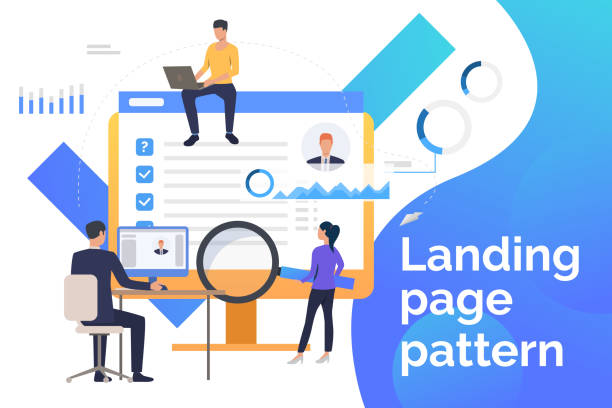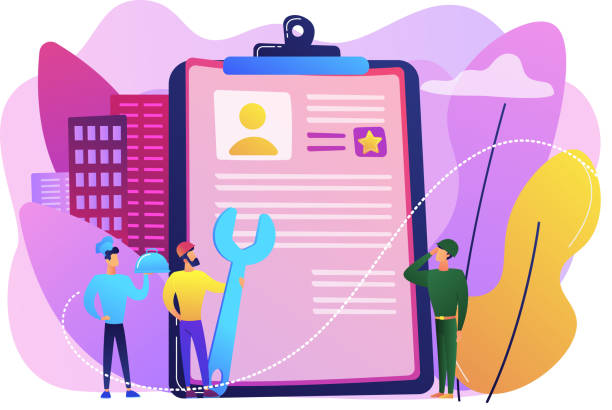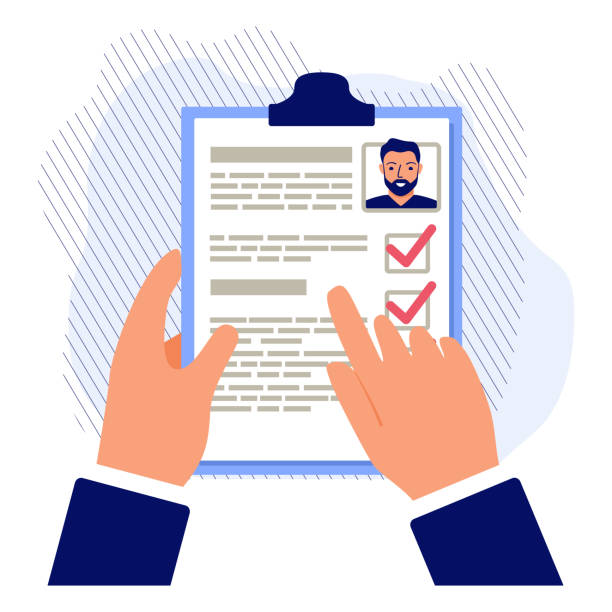Introduction to the Importance of Fast Website Design in the Digital Age

In today’s competitive world, where user attention changes at the speed of light, fast website design is no longer an option, but an absolute necessity.
Every second of delay in loading web pages can mean losing visitors, potential customers, and ultimately, revenue.
This phenomenon, known as #high_speed_website_design, not only affects user experience (UX) but also plays a vital role in search engine rankings (SEO).
Research shows that most users expect a website to load in less than three seconds, and if this expectation is not met, they quickly leave the site.
Therefore, website speed optimization is not just a technical discussion but a vital business strategy.
This section explains the concept and why website speed is important.
Are you losing business opportunities because of an outdated website? With Rasawb, solve the problem of not attracting potential customers through your website forever!
✅ Attract more high-quality leads
✅ Increase brand credibility in the eyes of customers
⚡ Get free consultation for corporate website design
Why Website Loading Speed is Crucial for User Experience and SEO?

The importance of user experience and SEO relies on fast website design.
Search engines like Google consider page loading speed as one of the key factors in ranking websites.
Slower websites typically rank lower in search results, which means reduced visibility and less traffic.
Furthermore, loading speed directly impacts the Bounce Rate; the slower your site, the more likely users are to leave before the page fully loads.
This high bounce rate sends a negative signal to search engines.
From a user’s perspective, a fast site conveys a sense of trust and professionalism, encouraging users to spend more time on the site and easily access the information they need.
This section analytically examines these aspects and highlights the importance of fast website design from an SEO and UX perspective.
Key Factors Affecting Website Speed and Specialized Solutions

Several factors affect your website’s loading speed, and identifying and resolving them is essential for fast website design.
One of the most important factors is image size and optimization.
High-volume images can place a heavy burden on the server and user bandwidth.
Using appropriate formats (like WebP), compression, and lazy loading images can make a significant difference.
Another factor is code optimization (HTML, CSS, JavaScript).
Removing extra code, minification, and concatenation of files help reduce the overall page size.
Choosing suitable hosting and using a Content Delivery Network (CDN) are also specialized solutions for increasing speed.
CDN significantly reduces loading time by storing your site’s content on multiple servers close to users.
This specialized and educational section explains these factors and provides practical solutions for achieving a fast-loading website.
| Slowdown Factor | Explanation | Optimization Solution |
|---|---|---|
| Heavy Images | High-volume images without proper compression. | Compression, changing format to WebP, Lazy Loading, appropriate dimensions. |
| Non-optimized Codes | Large, uncompressed CSS and JS files with many requests. | Minification, Combination, Asynchronous/Deferred loading (Async/Defer). |
| Inappropriate Hosting | Shared hosting with limited resources or servers far from the user. | Upgrade to VPS/Dedicated, choosing hosting near the audience, using CDN. |
| Lack of Caching | Failure to cache static content in the user’s browser. | Enabling browser cache, server cache, using caching plugins. |
Advanced Tools and Techniques for Website Speed Optimization

To achieve fast website design, you need to use specific tools and techniques that help you identify bottlenecks and implement improvements.
Tools like Google PageSpeed Insights, GTmetrix, and Pingdom Tools give you speed scores and offer suggestions for improvement.
Alongside these tools, techniques such as GZIP compression to reduce file sizes, database optimization, and using the HTTP/2 protocol can significantly impact website loading speed.
Using a suitable Content Management System (CMS) like WordPress, along with speed optimization plugins, is also a practical solution for many businesses.
This section provides a comprehensive guide to using these tools and techniques, helping you achieve a high-speed website.
Tired of losing customers due to poor e-commerce website design? With Rasawb, solve this problem forever!
✅ Increase sales and visitor-to-customer conversion rate
✅ Smooth and attractive user experience for your customers⚡ Get free consultation
The Role of Responsive Design in Loading Speed and Mobile Experience

In the current era, where a significant portion of internet traffic comes from mobile devices, Responsive Design not only means displaying the site correctly at any size but also plays a crucial role in fast website design and speed optimization for mobile users.
A responsive website is designed so that its content and elements adjust according to the user’s screen size.
This approach means preventing the loading of additional and irrelevant elements for smaller devices, leading to faster loading and a better user experience.
Google also places strong emphasis on mobile compatibility and website speed for mobile devices.
Ignoring this issue can lead to losing rankings in mobile searches and a significant decrease in traffic.
This section explains the importance of responsive design as an integral part of a high-speed website design strategy.
Common Web Design Mistakes That Lead to Slow Websites

On the path to fast website design, many developers and website owners make mistakes that unintentionally lead to slower speeds.
One of the most common mistakes is loading too many fonts, plugins, or external scripts, each creating new HTTP requests and increasing loading time.
Lack of caching and CDN usage is another major mistake that causes all content to be reloaded from the server every time a user visits the site.
Inefficient coding without attention to best practices (such as using inline CSS and JavaScript) can also drastically slow down speed.
Additionally, choosing cheap and low-quality hosting that cannot handle the traffic volume and site needs is considered one of the primary reasons for slowness.
This news and guide section aims to raise awareness about these common mistakes so that users can prevent them and move towards designing a high-speed website.
Success Stories of High-Speed Websites and Their Impact on Business

Fast website design is not just a technical term; rather, it hides many success stories of businesses that have revolutionized their online performance by optimizing their website speed.
For example, large e-commerce companies have seen a significant increase in their conversion rates and sales by reducing page loading times by just a few milliseconds.
A well-known case study showed that by improving speed, a retail company managed to increase its conversion rate by up to 8%.
These successes demonstrate that investing in website speed optimization is not just an additional cost but a smart investment with high returns.
Such entertaining stories remind us how website speed can directly impact customer loyalty, branding, and ultimately, profitability.
This news and entertainment section shares these successful experiences to illustrate the practical importance of high-speed web design.
| Metric | Change in Loading Speed | Improvement Result (Example) |
|---|---|---|
| Conversion Rate | 1 second reduction | 8% increase in conversion rate and sales. |
| Bounce Rate | 2 second reduction | 50% reduction in bounce rate. |
| SEO Ranking | Significant improvement in Core Web Vitals | Significant increase in keyword rankings. |
| Customer Satisfaction | Smoother user experience | Increased user loyalty and engagement. |
Future Trends in Website Speed Optimization and Challenges

The world of web is constantly evolving, and with it, the techniques and trends of fast website design are also advancing.
One significant trend is the increasing focus on Google’s Core Web Vitals, which include critical user experience metrics and directly impact SEO.
The future of web speed is moving towards broader use of Progressive Web Apps (PWAs), WebAssembly for high-performance code execution in the browser, and artificial intelligence for automatic content and resource optimization.
Challenges are not few; increasing content volume, design complexities, and higher demand for rich interactions can all hinder speed.
It is questionable how we can maintain the balance between a rich user experience and ultra-fast loading speed? This analytical section examines these future trends and challenges in the field of fast website design and provides a vision for the future of speed optimization.
Are you bothered by losing customers who visited your site to make a purchase?
Rasawb is your specialized solution for having a successful online store.
✅ Significant increase in your online sales
✅ Building trust and professional branding with customers⚡ Get free consultation from Rasawb specialists!
Choosing the Right Hosting and Platform to Achieve Maximum Speed

The foundation of fast website design is choosing the right infrastructure.
Your web hosting plays a key role in website loading speed.
Shared hosting is the cheapest option but has limited resources and can lead to slow sites, especially if your site has high traffic.
For high-speed websites and high-traffic websites, VPS (Virtual Private Server) or Dedicated hosting options are better, offering more control and resources.
Also, choosing the right platform or CMS is very important.
Platforms like WordPress, with themes and plugins optimized for speed, can be helpful in this regard.
For larger businesses, using cloud platforms like AWS or Google Cloud can be the ultimate solution for scalability and speed.
This section provides expert guidance for choosing the best hosting and platform for fast website design goals.
Maintaining Website Speed After Launch

Fast website design is not a one-time process but an ongoing commitment.
After launching a website, maintaining its speed is equally important.
Regular updates of plugins, themes, and CMS core (like WordPress) are crucial to prevent security and performance issues.
Continuous monitoring of website performance using tools like Google Analytics and Google Search Console can help identify any speed drops and technical problems.
Also, regular database cleanup, optimization of new content (images, videos), and periodic checks for broken links or chained redirects are among the actions that help maintain high site speed.
This educational and guidance section helps you manage and maintain your fast website design effectively after the process is complete, so it always remains at peak performance.
Frequently Asked Questions
| Question | Answer |
|---|---|
| What does fast website design mean? | Optimizing a website for fast page loading in users’ browsers, which leads to a better user experience and higher search engine rankings. |
| Why is website loading speed important? | Increased user satisfaction, reduced Bounce Rate, improved SEO, and increased conversion rates, as users expect sites to open quickly. |
| What factors affect website speed? | Image size, non-optimized coding (CSS, JS, HTML), inappropriate hosting choice, lack of caching, high number of HTTP requests, and non-use of CDN. |
| How can website loading speed be improved? | Image compression, code optimization and compression, using caching, enabling Gzip compression, using CDN, and choosing powerful hosting. |
| What is CDN and how does it help website speed? | CDN (Content Delivery Network) stores website content on different geographical servers, and the server closest to the user delivers the content, which reduces loading time. |
| How significant is the role of hosting in website speed? | Very significant. Powerful and suitable hosting with sufficient resources, high bandwidth, and optimized servers forms the foundation of a website’s speed. |
| How does image optimization affect website speed? | Images are usually the heaviest part of a web page. Compressing and optimizing them without significant quality loss greatly reduces page size and increases loading speed. |
| Does website speed affect SEO? | Yes, Google and other search engines consider website speed as one of the ranking factors. Faster websites have a better chance of ranking higher. |
| What tools are available to measure website speed? | Google PageSpeed Insights, GTmetrix, Pingdom Tools, and Lighthouse, each providing reports and suggestions for speed improvement. |
| How does caching help website speed? | Caching allows static website content to be stored for subsequent user visits. As a result, the browser does not need to re-download all content, and pages load much faster. |
And other services of Rasa Web Advertising Agency in the field of advertising
Smart Advertising Campaign: Revolutionize click-through rates by customizing user experience.
Smart Advertising Campaign: A new service for increasing digital branding through key page optimization.
Smart Custom Software: A new service for improving SEO ranking through SEO-driven content strategy.
Smart Advertising Campaign: A fast and efficient solution for user engagement with a focus on smart data analysis.
Smart Custom Software: A combination of creativity and technology to increase click-through rates by using real data.
And over a hundred other services in the field of internet advertising, advertising consulting, and organizational solutions
Internet Advertising | Advertising Strategy | Advertorial
Resources
Website Design Speed Secrets
Online Business Success Guide
Website Speed Optimization Tips
Web Design and Fast Loading
? For the growth and prosperity of your business in the digital world, Rasawb Afarin is with you every step of the way. With our comprehensive services, including responsive website design, professional SEO, and content marketing, we pave your path to success.
📍 Tehran, Mirdamad Street, next to Central Bank, Southern Kazerun Alley, Ramin Alley No. 6




